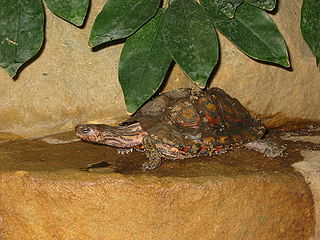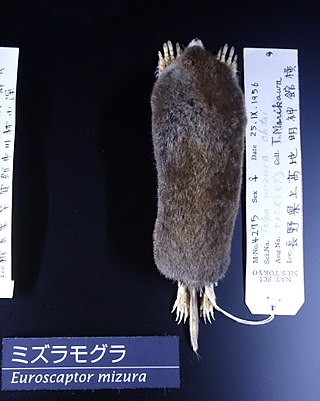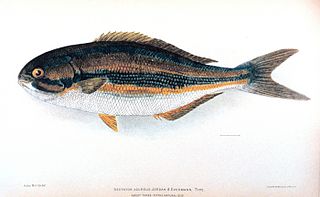
The rosefinches are a genus, Carpodacus, of passerine birds in the finch family Fringillidae. Most are called "rosefinches" and as the word implies, have various shades of red in their plumage. The common rosefinch is frequently called the "rosefinch". The genus name is from the Ancient Greek terms karpos, "fruit", and dakno, "to bite".

The family Cisticolidae is a group of about 160 warblers, small passerine birds found mainly in warmer southern regions of the Old World. They were formerly included within the Old World warbler family Sylviidae.

The Geoemydidae are one of the largest and most diverse families in the order Testudines (turtles), with about 70 species. The family includes the Eurasian pond and river turtles and Neotropical wood turtles. Members of this family are commonly called Leaf turtle.

Gymnophthalmidae is a family of lizards with at least 250 species, sometimes known commonly as spectacled lizards or microteiids. They are called "spectacled" because of their transparent lower eyelids, which allow them to still see with closed eyes. As in most lizards, except geckos, these eyelids are movable. The Alopoglossidae have been recently moved from this family.
In biology, a monotypic taxon is a taxonomic group (taxon) that contains only one immediately subordinate taxon. A monotypic species is one that does not include subspecies or smaller, infraspecific taxa. In the case of genera, the term "unispecific" or "monospecific" is sometimes preferred. In botanical nomenclature, a monotypic genus is a genus in the special case where a genus and a single species are simultaneously described. In contrast, an oligotypic taxon contains more than one but only a very few subordinate taxa.

The family Gryllidae contains the subfamilies and genera which entomologists now term true crickets. Having long, whip-like antennae, they belong to the Orthopteran suborder Ensifera, which has been greatly reduced in the last 100 years : taxa such as the spider-crickets and allies, sword-tail crickets, wood or ground crickets and scaly crickets have been elevated to family level. The type genus is Gryllus and the first use of the family name "Gryllidae" was by Francis Walker.

The Leptotyphlopidae are a family of snakes found in North America, South America, Africa and Asia. All are fossorial and adapted to burrowing, feeding on ants and termites. Two subfamilies are recognized.

Lanaria is a monotypic genus of flowering plants containing a single species, Lanaria lanata, endemic to the southern coast of South Africa where it is associated with the fynbos belt. Lanaria lanata is commonly known as Cape edelweiss or lambtails. The genus is placed in the monotypic family Lanariaceae, a family only recently recognized by taxonomists. The APG IV system of 2016 does recognize this family.

The Hainan gymnure or Hainan moonrat is a species of mammal in the family Erinaceidae. Its natural habitat is subtropical or tropical dry forests. It was thought to be endemic to the island of Hainan, China where it is threatened due to habitat loss, but in 2018 was found to also occur in, and be rather common, within Northern Vietnam.

The Japanese mountain mole is a species of Old World mole in the family Talpidae. It is endemic to Japan. It is the only member of the monotypic genus Oreoscaptor. Its natural habitats are temperate forests and temperate grassland.

The Mexican shrew is a species of mammal from the subfamily Soricinae in the family Soricidae. It is monotypic within the genus Megasorex and is endemic to Mexico.

The scrubfowl are the genus Megapodius of the mound-builders, stocky, medium-large chicken-like birds with small heads and large feet in the family Megapodiidae. They are found from south-east Asia to north Australia and islands in the west Pacific.

Chub is a common fish name. It pertains to any one of a number of ray-finned fish in several families and genera. In the UK, the term chub usually refers to the species Squalius cephalus. In addition, see sea chub.
Erythrobatrachus is an extinct genus of trematosaurian temnospondyl within the family Trematosauridae. The sole species Erythrobatrachus noonkanbahensis was separated to a monotypic genus, distinguishing it from related taxa when the description was published in 1972. The type material was a matrix cast revealing the impression of several fragments of skull excavated at the Blina Shale formation in the northwest of the Australian continent. The genus name is derived from ancient Greek, combining terms for red, erythro, with frog, batrachos, to describe the iron staining of the fossilised amphibian specimens. The type location described by the specific epithet was Noonkanbah Station.

The Pyxicephalidae are a family of frogs currently found in sub-Saharan Africa. However, in the Eocene, the taxon Thaumastosaurus lived in Europe.

Pyrgomorphidae is a family of grasshoppers in the order Orthoptera; it is the only family in the superfamily Pyrgomorphoidea. Pyrgomorphidae is found worldwide in tropical and warm temperate regions, but the vast majority of the family's approximately 500 species are from Africa, Asia and Australia. Their name is probably derived from pyrgos meaning "tower": a reference to the form (morph) of the head in the type genus Pyrgomorpha and other genera.

Marginellinae is a taxonomic subfamily within the larger family of Marginellidae, a group of small sea snails, marine gastropod molluscs in the superfamily Volutoidea.

The Solanaceae, or the nightshades, are a family of flowering plants that ranges from annual and perennial herbs to vines, lianas, epiphytes, shrubs, and trees, and includes a number of agricultural crops, medicinal plants, spices, weeds, and ornamentals. Many members of the family contain potent alkaloids, and some are highly toxic, but many—including tomatoes, potatoes, eggplant, bell and chili peppers—are used as food. The family belongs to the order Solanales, in the asterid group and class Magnoliopsida (dicotyledons). The Solanaceae consists of about 98 genera and some 2,700 species, with a great diversity of habitats, morphology and ecology.

Hog badgers are three species of mustelid in the genus Arctonyx. They represent one of the two genera in the subfamily Melinae, alongside the true badgers.
















